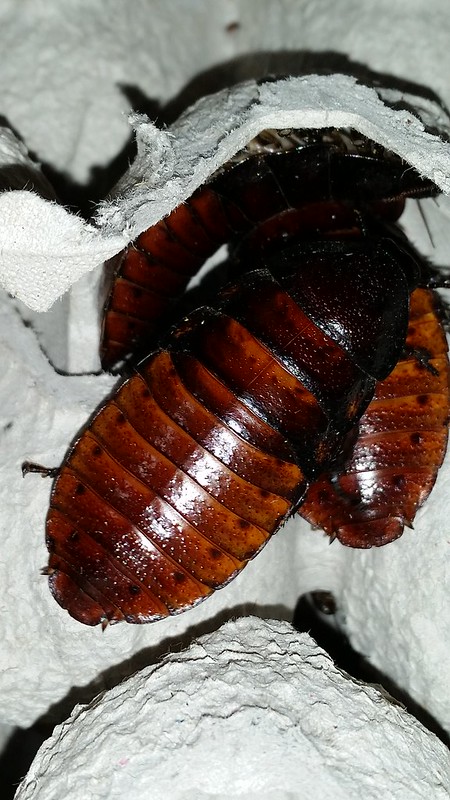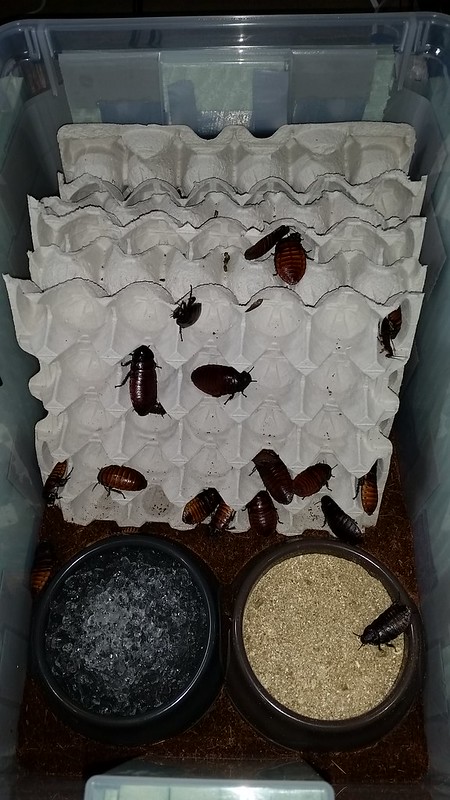
ptanner
-
Posts
28 -
Joined
-
Last visited
Content Type
Profiles
Forums
Events
Posts posted by ptanner
-
-
1 hour ago, varnon said:
Hi all, it has been a while, but I am making progress.
It took forever for my lab to be ready. They had to pull out carpet, add tile, and paint the walls. The space is nice, but a little small and oddly shaped. I searched hard for a rack to jam in this weird little corner, and I found one that fit perfectly! I found a website (https://www.webstaurantstore.com/search/regency-wire-shelves.html) where I can order wire shelves at many dimensions, and get the individual pieces, not just the kits.
I have 6 bins reserved for aquatic turtles on the second and third shelves. These shelves will have light units. I don't have them all installed yet. Wiring everything together is going to be tedious. Aside from that, it is bins to the ceiling! I probably won't have all 9 roach bins filled at once, but it is nice to have the space.
I still have to install vents on the bins. Any thoughts on front vs top mounted vents? And then the heat source. The turtle lights may create enough ambient heat, or I might still need to do something different. I won't have space for a light in front of the rack like allaboutinsects suggested. The ventilation and temperature in this room is erratic, so everything will have to be thermostat controlled no mater what I do.
I'm really looking forward to finishing this. Thanks to this forum for all the inspiration.
Nice setup. For safety purposes, I would not have electric equipment below tubs with water in them. In my opinion, that is an unnecessary risk.
As for heat, how much does the room fluctuate? Do you want these colonies to breed a lot (like feeder Dubia colonies) or just live? If the room stays around 70 and rapid reproduction is not a necessity, I would not worry about heat. The turtle lamps will definitely give off some ambient heat. before putting in any roaches I would set up a digital thermometer that keeps track of the high and low temperatures so you can see how much it fluctuates without the turtle lights and plan accordingly.
Those bins are also the largest ones available and can hold A LOT of roaches, so I would scale down to the smaller bins and save these for extremely large colonies or species that do not do well with crowding. All my colonies start in small bins and progress in size as the colony grows.
-
1 hour ago, varnon said:
I just finished setting up my rack and bins. Will be adding vents to mine soon. On checking this thread again, I realize we ended up with the same plastic tubs! They are the only tubs that have a really good fit for my rack.
Any thoughts (from anyone) on top vs front mounted vents? How much space should I have between one lid and the next (wire) shelf to keep good ventilation?
Those tubs are the best! been using them for years and have never had any issue or an escapee. They are the only tubs I recommend because you do not need a barrier layer.
With wire racks like that, enough space to slide each bin straight in and out of the rack should be enough space for ventilation. I prefer vents mounted on the lid versus the sides but that is just my personal preference. I think the main issue would be if you did not have a shelving unit and needed to stack the bins on one another, then front/side mounted vents would be the better of the two. Plus, lid-mounted vents will allow deeper substrate for some species.
-
You could also put bungie cords across the front, back, and sides of shelves. That should keep any from sliding off.
-
 2
2
-
-
Yes, they are all dubia. #7-10 look to be juveniles, not adults.
-
 1
1
-
-
That is gorgeous!
-
You can definitely use substrate, plants, and tank decor. I recommend coco coir for a substrate (I prefer Eco Earth bricks but others prefer more generic varieties). Of course this will also depend on if you want to breed them a lot or just keep them for display.
-
Looks familiar lol. Definitely a more in-depth step-by-step guide than what I posted a few years ago.
-
-
I realize this post is a month old, but I have been using the Zoo Med Reptitherm UTH 10-20 gallon and the 30-40 gallon on plastic totes for years and have not had any issues. I also hook them up to Lutron Credenza light dimmers to regulate power output.
-
Send Zephyr a pm. He is the one that did the Blatticomposting project for the University of Michigan, Dearborn. He also runs www.roachcrossing.com
-
Dead roaches are not necessarily a problem for my hissers. It is just the fact that all the really old ones are finally starting to die off. I check regularly and remove the dead. They are not in a display, just in a Sterilite-type enclosure. I am using them for a few projects, so there is no need for a display...yet. If I had a naturalistic display, then I would get cleaner crews and have an entire ecosystem. I have not had a problem with mites, maggots, or anything else of that nature, but I appreciate the info and will keep it in mind when I finally do make my display enclosures.
-
Thank you both for your responses. I love the look of both species. The big things are smell, crowding, and eating their dead. Besides my G. portentosa, all my other species have eaten their dead, which is great for maintenance and cleanliness. I hate having to always remove the bodies of my old-age hissers. As for the crowding, I want to breed decent-sized colonies for both feeders and display. And, of course, I want as low an odor as possible for obvious reasons.
-
Hey everyone,
Just a few questions for those of you that have these two species. Which one has the least odor and how does each compare to other species that have an odor? Which one reproduces faster? I know E. distanti will eat their dead, but will B. craniifer do the same? Does one species handle crowding better than the other? Which of the two species do you prefer and why? I would get both species and most likely will in the future, but I only want to add one species to my collection at a time.
Thanks ahead of time for any info you may have.
-
Thank you very much. Since the egg crates are right over the heat mat, they trap the heat. Inside the egg crate is around 85-90 degrees, just to the side of them stays around 83 degrees, and the rest of the bin stays about 80. I set up my bins this way because I am not going to heat my entire studio apartment to 90 degrees lol. The initial set-up is a bit pricey, but it works and is cheaper than heating entire rooms.
-
Very interesting paper, especially that it is from 1970 and so well documented! Definitely spurs the mind to wonder what other hybrids may be possible. Of course, only in a controlled environment and not circulated throughout the hobby.
-
-
-
-
disregard...again
I even switched sites from Flickr to Photobucket and it still is not working.
-
Disregard
-
Still cannot add photos. Please disregard the last couple posts. I am trying to figure out how to add pics. I already read the post on this forum about it, but that is not working.
-
Apparently I cannot add any pics.
-
Enclosure finished. Gromphadorhina portentosa colony has been in place for to weeks and all individuals are doing well.
-
The only thing I can think of would be to empty the bin, clean it out, and set it back up with all new egg crates or whatever else you have in it.
Is there any way you could upload a photo of it?






SO EXCITED
in General Blattodea Discussions
Posted
Awesome! Mine was delivered last week and it is FANTASTIC!